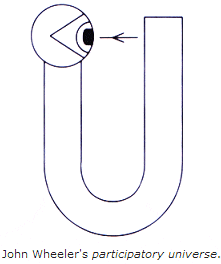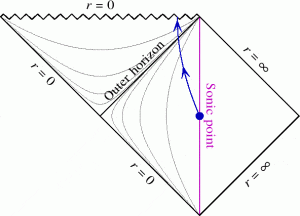Wonderments of Cosmos Seminar 2: David Burrows
By Lucy M J Calder, on 19 March 2014
Another brilliant seminar on Tuesday 4th March, with David Burrows (Slade school of Fine Art), followed by responses from Dina Gusejnova (UCL History) and Martin Holbraad (UCL Anthropology).
Download the whole seminar (audio) HERE.
Not only was every place available for this event taken up on Eventbrite, but David invited his students from the Slade along to watch him, which made for a very full room indeed, with students sitting two and three abreast in the aisle between the seats and packed into the floor space at the front. Apologies for the squash to anyone who was there, but it did help generate a buzz.
David Burrows remains unperturbed by the large crowd and launches into his talk’ entitled Negative Space in the diagrammatic imaginary of science and art. He is, he tells us, going to talk about black holes, but from the perspective of art rather than science. He has a good grasp on the physics, gleaned from popular science books, but he is more concerned with the representation and presentation of black holes. These attempts to present the data through the use of diagrams mark out, he suggests, a ‘diagrammatic imaginary’. Drawing on the work of Kant and the French philosopher Michele Le Doeuff, Burrows proposes that certain problems require or solicit images, and that black holes are particularly relevant because they are ‘only perceived and present to us through a diagrammatic imaginary.’ Human beings can only ever encounter black holes in their minds, through thought experiments, not in actual space.
Beyond the event horizon of a black hole, time and space morph into one another, and physics breaks down at a singularity in the centre, where all mass is apparently crushed to nothing. Even artists, specialists in the ‘presentation of presentation’, are challenged when it comes to presenting this scenario. There is a tension between mathemes (lessons in structures or relations, that which can be taught) and pathemes (the affects of structures and relations), which relates to the different orientations of science and art.
 Recently, philosophers and artists have valued science for its ability to turn the accepted order upside down, from Copernicus pointing out that the Earth isn’t at the centre of the Universe, to the more recent off-planet perspectives engendered by contemporary astrophysics.
Recently, philosophers and artists have valued science for its ability to turn the accepted order upside down, from Copernicus pointing out that the Earth isn’t at the centre of the Universe, to the more recent off-planet perspectives engendered by contemporary astrophysics.
Burrows suggests that, like Western art, diagrammatic practices are also concerned with the presentation of presentation. Furthermore, and most relevantly in this seminar, diagramming is a trans-disciplinary practice since diagrams are common throughout all the university disciplines.
We are here introduced to Gilles Chatelet’s book: Figuring Space: Philosophy, Mathematics and Physics (1993), in which the author, a French philosopher and mathematician, ‘defines diagrams as gestures that invite further gestures.’ Chatelet finds violence in the gestures of diagramming and says that these gestures are a means to explore potentialities/ what might eixst. Interestingly, Chatelet points out that the vanishing point in perspective drawings, which is necessary to unify the diagram, is always inaccessible and outside the presentation. However if we place ourselves at this blind horizon point we can explore all possible perspectives. Einstein surely did this when he imagined the world from the point of view of a photon, and proposed an ultimate speed limit for light.
Bruno Latour’s actor network theory is, said Burrows, also helpful to the discussion of diagrammatic thought. The separation of the study of the human and the non-human has produced a blind spot, in which hybrids come into existence. Diagrams, in mediating data between object and subject, or subject and subject, can be thought of like Latour’s subject/object hybrids.
Black holes can be thought of as horizon points, or blind spots, which can give us a new perspective on the universe, and Burrows asks whether art can contribute to their diagrammatic imaginary. He concludes by talking us through some images of modern and contemporary art, pointing out the common use of the term ‘negative space’ in art school to refer to the spaces between objects. By thinking about these spaces, the artist is better able to compose a drawing. In abstract art, negative and positive spaces can very quickly transpose, and the Cubists of the early 20th century demolished master-point perspective and attempted to produce four-dimensional images. They were influenced by the mathematician Henri Poincare, if not by Einstein’s recent theories of relativity.
Out of the experiments of the Cubists came the work of artists such as Luibov Popova, whose abstract paintings are, Burrows points out, similar to the allusive devices Chatelet describes in scientific diagrams. Throughout the last century and in to this one, there has continued to be interference between the work of artists and that of scientists. For example, Yayoi Kusama’s cosmic dot paintings play with collapsing figure and ground – the loss of sense of where everything starts and ends – at a time when quantum uncertainty was becoming established in physics.
In a suitably contemporary art manner, I will quote Burrows describing Chatelet quoting Schelling, who (Schelling) ‘argues that thought is not in the brain or in scientific figures or words but in the morning dew. Just as likely, thought is in the black holes and singularities that force a diagrammatic imaginary, that sends minds racing to an outside beyond visible and human horizons. In this the diagrammatic imaginary and non-human orientations of science might be placed in productive relation with the art that seeks new forms of presentations through a concern for the artifice of mediations, and a feel for negative space.’
Download the whole seminar (audio) HERE.
By this time there is a palpable sense of intellectual excitement in the crowded room. Dina Gusejnova from the History department stands up next. She notes that the BBC had announced a few weeks ago the headline ‘Black holes do not exist!’, a story based on Stephen Hawking’s recent theory that black holes can exist without definite event horizons, the point at which no information can escape them. What repercussions might the non-existence of black holes have for her, she wonders. They were a beautiful concept of the unknown – necessary as a horizon of limits of thinking, as a foil for what we do know, in a similar way that Malevich’s Black Square relates to one of Renoir’s figurative paintings. But just as Malevich’s painting is showing signs of age, so are black holes. Perhaps they are now in the dustbin of history and Burrow’s talk can be seen as a eulogy for them.
She wants to give three answers to the question: what have black holes done for us, and can we still keep them? And extracts 3 themes from David’s paper. Firstly, black holes are a marker for historians of archaic modernity, the fact that the Enlightenment was never really an Enlightenment and we moderns have never really been modern, as Latour says. Secondly, black holes reveal something about the structure of our imagination. Even if these ones have now been written out of existence, they will be replaced by other and better black holes. Thirdly, black holes might reveal something about visual representation and political representation and about a certain form of utopian thinking.
She goes on to explain these themes more fully, and ends with a question to David: is it better to keep black holes in our minds, even if Stephen Hawking decides to declare them non-existent?!
Burrows says yes. In fact, Hawking has not said there is no such thing as black holes, only that the event horizon is not as imagined by classic General Relativity. So we still have to believe in them, but whether they are useful to us or not is open to debate. In his opinion, what is useful about them is they’re not human –they’re beyond us and we can have no effect on them. Furthermore, the idea that there is no spacetime in a singularity is an incredible idea to think about – it’s an idea that messes with your head!

A Feynman diagram demonstrating an annihilation of an electrons (e-) and a positron (e+) into a photon (γ) that then produces an e+e- pair.
Martin Holbraad is the second respondent. He remarks that an underlying concern of this series is the two cultures debate. The worst outcome would be simply to reiterate the old arguments and get no further forward. The idea of negative space and figure-ground reversal where things indexically point at each other, rather than oppose each other, is perhaps a better metaphor to use to compare Ofer’s ‘hard science’ talk last week with the art informed talk we listened to today.
Scientists often make a hierarchical distinction when they talk about knowledge, between science proper and pop science. They make a distinction between physical theories based on observational data, which are esoteric because you need to be able to do the maths, and the metaphorical ways in which these data are conveyed to the wider public. Hard science versus public engagement. Dilwyn Knox drew attention to the historical depth of the metaphors Ofer used to describe the science, but a tendency when presenting the historical depth of these ideas is to think you’re somehow debunking science. In fact the scientist can simply retort that we’ve only debunked the metaphors, not the hard science. Burrows’ argument about the diagrammatic imaginary could suggest a third path, between the metapohric and the mathematical. What scientists deal with are particular forms of conceptualisation: the realm of the thought experiment, which Einstein used so effectively; or conceptual configurations such as the event horizon, compared to the vanishing point in art. Burrows referred to the ‘warped side of the universe’. There is a warping of our own conceptual repertoire when we try to engage in thinking about the universe. Perhaps some working scientists find these kinds of non-scientific appeal to quantum theory etc a bit blithe and tell the non-scientists they don’t know what they’re talking about, but this can feel quite chauvinistic when you’re on the receiving end! What we should do, as non-scientists, is to use these concepts with care, rather than debarring ourselves from using them at all.
There follows an animated discussion between artists and scientists in the room about how far conceptualisations can act as a bridge between the disciplines.
For example, a particle physicist from the LHC tells Burrows that, while he has enjoyed the talk, it wasn’t about black holes. He himself wouldn’t dare to discuss black holes in public because he doesn’t understand all the theory. To really understand a scientific theory you have to work through the maths, otherwise you can form an image but it’s just not the same thing.
Burrows replies that his talk was more concerned with the diagrammatic imaginary than with black holes. What Chatelet is so good at is he shows, within scientific diagrams, the diagrammatic imaginary at work. Even though he is not going to get to the same level of mathematical understanding as the particle physicist, they can still have a conversation about how they understand the world. He doesn’t think there’s a direct synthesis between science and art. A direct translation is impossible. But scientific endeavours can have much wider effects beyond those they set out to achieve, and here he takes the moon landings as an example. A University needs opportunities, such as these seminars, where different disciplines can meet, if only to make diagrams that clash.
 Close
Close





